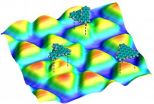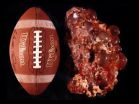(Press-News.org) Electronic components are getting smaller and smaller, with microelectronic components gradually being replaced by nanoelectronic ones. On nanoscale dimensions, silicon, which is at the present stage the most commonly used material in semiconductor technology, reaches however a limit, preventing further miniaturization and technological progress. New electronic materials are therefore in great demand. Due to its outstanding electronic properties, graphene, a two-dimensional carbon network, is considered as a possible replacement. However, several obstacles must be overcome before graphene can be used in semiconductor technology. For instance, currently there is no easily applicable method for large-scale processing of graphene-like materials.
Empa researchers of the nanotech@surfaces Laboratory reported on a surface chemical route to fabricate small fragments of graphene, so-called nanographenes. Using a prototypical polyphenylene precursor, the researchers clarified, together with scientists at the Max Planck Institute for Polymer Research in Mainz (Germany) and the University of Zurich, how the reaction pathway runs in detail on a copper surface und how the building blocks can be transformed into planar nanographenes directly on the surface. The work has been published last Sunday in the scientific journal Nature Chemistry as an advanced online publication.
Successful partners: experiment and simulation
For their investigations the researchers combined empirical observations, in particular from scanning tunnelling microscopy with computer simulations. The simulations are used to determine whether a theoretically possible reaction step is energetically possible or not. The result: the reaction pathway consists of six steps with five intermediate products. Two of them are stabilised by the surface so that they can be stably imaged with the scanning tunnelling microscope. The reaction barriers connecting the different intermediates are lowered through a catalytic effect of the substrate.
To be capable of being integrated in electronic circuits, the graphene-like material must however be manufactured on semiconductor surfaces instead of metal ones. The researchers have simulated whether their approach could also work on these surfaces and the results are very promising, showing that surface-supported synthesis is a possible way to fabricate tailored nanographenes on a range of different substrates.
The three pillars of today's science: theory, experiment, and simulation
Progress in today's scientific research relies at the same time on theory, experiments, and to an increasing extent on computer simulations. These simulations are complementary to often complex lab experiments and make it possible to get further information that cannot be obtained with experimental methods alone. The combination of experiments and simulations as well as the deduced theories therefore allow for a more and more accurate explanation and precise prediction of natural phenomena.
INFORMATION:
Step by step toward tomorrow's nanomaterial
Empa researchers clarify reaction pathway to fabricate graphene-like materials
2010-11-12
ELSE PRESS RELEASES FROM THIS DATE:
Circuitry of fear identified
2010-11-12
Fear arises in the almond-shaped brain structure known as the amygdala. It is the amygdala which processes the strange noise, shadowy figure or scary face and not only triggers palpitations or nausea but can also cause us to flee or freeze. That much has long been known about the function of this part of the brain. What remains largely unclear, however, is precisely how fear develops, and which of the countless neurons in the amygdaloid region are involved in this process. But finding answers to these questions is vital for those who wish to improve the quality of life ...
African dust caused red soil in southern Europe
2010-11-12
Spanish and American researchers have conducted a mineralogical and chemical analysis to ascertain the origin of "terra rossa" soil in the Mediterranean. The results of the study reveal that mineral dust from the African regions of the Sahara and Sahel, which emit between 600 and 700 tonnes of dust a year, brought about the reddish soil in Mediterranean regions such as Mallorca and Sardinia between 12,000 and 25,000 years ago.
"The first hint of the relationship between African dust and certain soils in the region of the Mediterranean is their reddish or reddish-brown ...
Alcohol damages much more than the liver
2010-11-12
MAYWOOD, Ill. -- Alcohol does much more harm to the body than just damaging the liver. Drinking also can weaken the immune system, slow healing, impair bone formation, increase the risk of HIV transmission and hinder recovery from burns, trauma, bleeding and surgery.
Researchers released the latest findings on such negative effects of alcohol during a meeting Nov. 19 of the Alcohol and Immunology Research Interest Group, held at Loyola University Medical Center.
At Loyola, about 50 faculty members, technicians, post-doctoral fellows and students are conducting alcohol ...
Leaking underground CO2 storage could contaminate drinking water
2010-11-12
DURHAM, N.C. -- Leaks from carbon dioxide injected deep underground to help fight climate change could bubble up into drinking water aquifers near the surface, driving up levels of contaminants in the water tenfold or more in some places, according to a study by Duke University scientists.
Based on a year-long analysis of core samples from four drinking water aquifers, "We found the potential for contamination is real, but there are ways to avoid or reduce the risk," says Robert B. Jackson, Nicholas Professor of Global Environmental Change and professor of biology at ...
Sugar and slice make graphene real nice
2010-11-12
HOUSTON -- (Nov. 11, 2010) -- Future computers may run a little sweeter, thanks to a refinement in the manufacture of graphene at Rice University.
Rice researchers have learned to make pristine sheets of graphene, the one-atom-thick form of carbon, from plain table sugar and other carbon-based substances. They do so in a one-step process at temperatures low enough to make graphene easy to manufacture.
The lab of Rice chemist James Tour reported in the online version of the journal Nature this week that large-area, high-quality graphene can be grown from a number of ...
Scripps Research scientists identify new mechanism regulating daily biological rhythms
2010-11-12
JUPITER, FL, November 9, 2010 – For Immediate Release – Scientists from the Florida campus of The Scripps Research Institute have identified for the first time a novel mechanism that regulates circadian rhythm, the master clock that controls the body's natural 24-hour physiological cycle. These new findings could provide a new target not only for jet lag, shift work, and sleep disturbances, but also for disorders that result from circadian rhythm disruption, including diabetes and obesity as well as some types of cancer.
The study is published in the November 12, 2010 ...
Arsenic early in treatment improves survival for leukemia patients
2010-11-12
WINSTON-SALEM, N.C. – Thursday, Nov. 11, 2010 – Arsenic, a toxic compound with a reputation as a good tool for committing homicide, has a significant positive effect on the survival of patients with acute promyelocytic leukemia (APL), when administered after standard initial treatment, according to a new, multi-center study led by a researcher at Wake Forest University Baptist Medical Center.
While arsenic trioxide (As2O3) is known by clinicians to be a highly effective treatment for patients with relapsed APL, its benefit earlier in treatment, after first remission, ...
Common diabetes drug may halt growth of cysts in polycystic kidney disease
2010-11-12
INDIANAPOLIS – Researchers report that a drug commonly used to treat diabetes may also retard the growth of fluid-filled cysts of the most common genetic disorder, polycystic kidney disease. PKD does not discriminate by gender or race and affects one in 1,000 adults worldwide.
Researchers from the schools of Science and Medicine at Indiana University-Purdue University Indianapolis and colleagues from the Mayo Clinic report this month in the online peer-reviewed journal PPAR Research that pioglitazone appears to control the growth of PKD cysts.
Using a rat model that ...
Additional cardiac testing vital for patients with anxiety and depression
2010-11-12
Montreal, November 11, 2010 – People affected by anxiety and depression should receive an additional cardiac test when undergoing diagnosis for potential heart problems, according to a new study from Concordia University, the Université du Québec à Montréal and the Montreal Heart Institute.
As part of this study, published in the Journal of Cardiopulmonary Rehabilitation and Prevention, a large sample of patients received a traditional electrocardiogram (ECG), where they were connected to electrodes as they exercised on a treadmill. Patients also received a more complex ...
New research provides effective battle planning for supercomputer war
2010-11-12
New research from the University of Warwick, to be presented at the World's largest supercomputing conference next week, pits China's new No. 1 supercomputer against alternative US designs. The work provides crucial new analysis that will benefit the battle plans of both sides, in an escalating war between two competing technologies.
Professor Stephen Jarvis, Royal Society Industry Fellow at the University of Warwick's Department of Computer Science, will tell some of the 15,000 delegates in New Orleans next week, how general-purpose GPU (GPGPU) designs used in China's ...
LAST 30 PRESS RELEASES:
Orthopedics can play critical role in identifying intimate partner violence
Worms as particle sweepers
Second spider-parasitic mite described in Brazil
January 2026 issues of APA journals feature new research on autism, pediatric anxiety, psychedelic therapy, suicide prevention and more
Private equity acquired more than 500 autism centers over the past decade, new study shows
New cervical cancer screening guidelines from the US Department of Health and Human Services
Estimated burden of COVID-19 illnesses, medical visits, hospitalizations, and deaths in the US from October 2022 to September 2024
Smartphone use during school hours by US youth
Food insecurity and adverse social conditions tied to increased risk of long COVID in children
Earliest, hottest galaxy cluster gas on record could change our cosmological models
Greenland’s Prudhoe Dome ice cap was completely gone only 7,000 years ago, first GreenDrill study finds
Scientific validity of blue zones longevity research confirmed
Injectable breast ‘implant’ offers alternative to traditional surgeries
Neuroscientists devise formulas to measure multilingualism
New prostate cancer trial seeks to reduce toxicity without sacrificing efficacy
Geometry shapes life
A CRISPR screen reveals many previously unrecognized genes required for brain development and a new neurodevelopmental disorder
Hot flush treatment has anti-breast cancer activity, study finds
Securing AI systems against growing cybersecurity threats
Longest observation of an active solar region
Why nail-biting, procrastination and other self-sabotaging behaviors are rooted in survival instincts
Regional variations in mechanical properties of porcine leptomeninges
Artificial empathy in therapy and healthcare: advancements in interpersonal interaction technologies
Why some brains switch gears more efficiently than others
UVA’s Jundong Li wins ICDM’S 2025 Tao Li Award for data mining, machine learning
UVA’s low-power, high-performance computer power player Mircea Stan earns National Academy of Inventors fellowship
Not playing by the rules: USU researcher explores filamentous algae dynamics in rivers
Do our body clocks influence our risk of dementia?
Anthropologists offer new evidence of bipedalism in long-debated fossil discovery
Safer receipt paper from wood
[Press-News.org] Step by step toward tomorrow's nanomaterialEmpa researchers clarify reaction pathway to fabricate graphene-like materials




